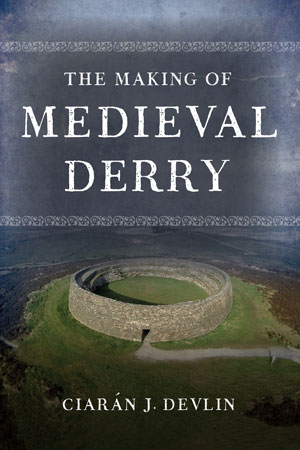THE MAKING OF MEDIEVAL DERRY
Published in Book Reviews, Book Reviews, Issue 3 (May/June 2019), Reviews, Volume 27CIARÁN J. DEVLIN
Four Courts Press
€22.45
ISBN 9781846827556
Reviewed by: Sparky Booker
Sparky Booker lectures in medieval history at Queen’s University, Belfast.
 It is clear when reading The making of medieval Derry that it is the fruit of a life’s work; it is characterised by an impressive depth and richness of detail, as well as a love for the locality that springs from the author’s many years of living in and studying the diocese. The late Fr Kieran Devlin (Ciarán Ó Doibhlin) was a parish priest in Derry as well as the diocesan archivist, and his identification with the diocese is revealed in subtle as well as in more obvious ways (from the subsection titled ‘our parishes’ to his asides about local topography and the landscape).
It is clear when reading The making of medieval Derry that it is the fruit of a life’s work; it is characterised by an impressive depth and richness of detail, as well as a love for the locality that springs from the author’s many years of living in and studying the diocese. The late Fr Kieran Devlin (Ciarán Ó Doibhlin) was a parish priest in Derry as well as the diocesan archivist, and his identification with the diocese is revealed in subtle as well as in more obvious ways (from the subsection titled ‘our parishes’ to his asides about local topography and the landscape).
It is a deeply personal book. Fr Devlin eschews the detached tone of much professional history and is unapologetic about this choice. He prefaces a discussion of St Columba with the assertion that he must deal with the myths about the saint alongside the historical information we have about his life, since ‘both realities are actual, if not necessarily factual’. He goes on to say that ‘examining such matters [major turning points in a people’s history] merely in terms of logic and intellect results in that sterile cerebration that appears likely to be a doubtful legacy of the late twentieth-century mind, dismissing as it does any view of the human condition that is not “scientific”’. He succeeds in producing prose that is far from sterile: the mix of myth, folklore and history on display and Devlin’s free comparisons between the medieval and the modern world, incorporating references to the Troubles, the World Wars and modern debates about the place of the clergy in 21st-century Irish society, provide an immediacy and intimacy to this discussion of the medieval world that is rare.
His focus on the individual—shown most of all in his chapter of biographical sketches, ‘Medieval Personalities’, but evident throughout the book—furthers this sense of connection between medieval and modern. So too do anecdotes highlighting the continued relevance of medieval Irish people in the modern world, like that detailing the ongoing veneration of Conchobur mac Meic Conchoille, a mid-twelfth-century archbishop of Armagh, as ‘St Concord’, a patron saint of rain in south-eastern France. And yet a slightly more restrained approach would have been welcome to this reader, along with some greater signalling of when he is recounting myth or local tradition and when his account is based on historical events for which there is more solid evidence. The engaging style of the book can at times be not just conversational but perhaps even meandering. It is not fair to judge the structure too harshly, however, given that Fr Devlin’s untimely death prevented him from having the chance to edit the manuscript in its final form. It also prevented him from adding a great number of references; this can be frustrating for the historian who wants to chase up a specific reference or comment, but it adds to the charming informality and readability of the work. This readability will increase its appeal to a general audience, and sections like the appendix ‘How did people live’ is particularly attractive for the interested non-academic reader who might want to know about daily life, clothing, food, drink, religious observance, marriage and family in medieval Ireland.
In terms of scholarship, this book is most valuable for the information it contains about the history of each parish in the diocese of Derry and for the painstaking detective work that Fr Devlin conducted into surnames, notable persons from the diocese, the histories of local families and place-names. This includes an appendix on the local surnames of Derry with commentaries about their origin and how they have changed over time. The information comes from an impressive range of historical, archaeological, toponymic and other sources. The excellent and detailed indices of persons, places and population groups in addition to subject and source indices prepared by Nollaig Ó Muraíle make it of even greater value for anyone interested in the history of Derry. It is of somewhat less value for commentary on historical events of the medieval period outside the diocese, and some sections display somewhat old-fashioned historiographical outlooks and even a touch of Christian triumphalism.
In sum, there are elements of this book that could have benefited from more attention to the historiography of the last few decades, but it remains a valuable work of local history and must be applauded for the depth of research and attention to detail that underlie its discussion of the diocese of Derry in the medieval period.
















